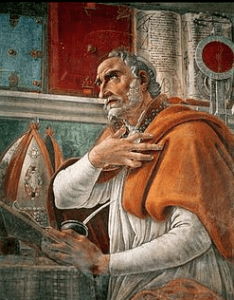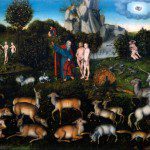 A topic that comes up often in the discussion of science and religion is Stephen Jay Gould’s concept of non-overlapping magisteria or NOMA. I’ve read many papers and books that refer to this principle – sometimes agreeing, more often disagreeing significantly from both sides. There are those who disagree with the concept, wanting to put religion out of the picture all together, and those who disagree, wanting to subject science to religious ideals or because the separation seems somewhat artificial. David Barash, an evolutionary biologist and psychology professor at the University of Washington whose NY Time opinion piece was the subject of a post a few weeks ago Coming Soon … “The Talk”? finds Gould’s argument for NOMA particularly troubling.
A topic that comes up often in the discussion of science and religion is Stephen Jay Gould’s concept of non-overlapping magisteria or NOMA. I’ve read many papers and books that refer to this principle – sometimes agreeing, more often disagreeing significantly from both sides. There are those who disagree with the concept, wanting to put religion out of the picture all together, and those who disagree, wanting to subject science to religious ideals or because the separation seems somewhat artificial. David Barash, an evolutionary biologist and psychology professor at the University of Washington whose NY Time opinion piece was the subject of a post a few weeks ago Coming Soon … “The Talk”? finds Gould’s argument for NOMA particularly troubling.
I tend to think that the separation into separate magisteria is somewhat artificial, but had never read Gould’s argument directly from his own work. This didn’t seem wise, so I picked up a copy of his book Rocks of Ages: Science and Religion in the Fullness of Life where the concept is explained in detail. The range in the amazon reviews, almost equally spread from 1 to 5, give a flavor for the controversy over his proposal. Gould is anything from wise and thoughtful offering a useful framework to a fool, out of his depth, misinterpreting religion, and capitulating to those who believe in bronze age myths. The most scathing reviews come from atheist readers. This may be interesting.
Before digging too deeply into Gould’s argument it is necessary to understand what he means by magisterium … which is not to be confused with the similar words majesty or majestic (apparently a confusion he encountered).
A magisterium, on the other hand, is a domain where one form of teaching holds the appropriate tools for meaningful discourse and resolution. In other words, we debate and hold dialogue under a magisterium; we fall into silent awe or imposed obedience before a majesty.
[The magisterium] of science covers the empirical realm: what is the universe made of (fact) and why does it work this way (theory). The magisterium of religion extends over questions of ultimate meaning and moral value. These two magisteria do not overlap, nor do they encompass all inquiry (consider for example the magisterium of art and the meaning of beauty) (p. 5-6).
Although Gould often has Christianity and Judaism in mind as he makes his argument, his definition of religion isn’t constrained to anything resembling Christian faith (or any other religion). It might be better to use the term moral philosophy rather than religion. But the Christian faith as it provides a moral philosophy is one example of an approach to the magesterium of religion.
The realms of science and religion concerning life. Some questions concerning the origin and diversity of life are scientific questions subject to the magisterium of science. Why do we look so much like the apes? What is the age of the earth? Why is there so much non protein coding DNA? What is the mechanism for change over the ages? What caused the five mass extinctions that have punctuated evolutionary history?
[S]uch questions fall under the magisterium of an institution that we have named “science” – a teaching authority dedicated to using the mental methods and observational techniques validated by success and experience as particularly well suited for describing, and attempting to explain, the factual construction of nature. (p. 54)
Other questions such as the origin of disease, the best treatment and containment strategies for Ebola, and the importance of prenatal care are also scientific questions.
But there are questions that science cannot address. It simply does not have the right set of tools. “Are we worth more than bugs or bacteria?” and “Do we violate any moral codes when we use genetic technology to place a gene from one creature into the genome of another creature?” are examples that Gould gives. A more timely example might be the value placed on a child to be born with Down’s syndrome. Richard Dawkins created quite a stir back in August by suggesting that it would be immoral not to abort a baby known to have Down’s syndrome. (See this article from the Guardian, this opinion piece in the NY Times, or simply search for Dawkins and Down’s Syndrome for a number of links to reports from a range of sources.)
According to Gould’s proposal …
Such questions … engage different concerns that simply cannot be answered, or even much illuminated, by factual data of any kind.
These questions address moral issues about the value and meaning of life, both in human form and more widely construed. Their fruitful discussion must proceed under a different magisterium, far older than science (at least as a formalized inquiry), and dedicated to a quest for consensus, or at least clarification of assumptions and criteria, about ethical “ought,” rather than a search for any factual “is” about the material construction of the natural world. (p. 55)
This separate magisterium is that Gould terms religion. We must all construct a moral and philosophical framework for dealing with these important questions of ethical value and moral behavior. Insights from science can be integrated into this framework – but science cannot address these questions directly. It simply isn’t the role or focus of scientific endeavor.
I … construe as fundamentally religious (literally binding us together) all moral discourse on principles that might activate the ideal of universal fellowship among people. (p. 62)
And a bit later he parenthetically explains,
The vitality of this magisterium lies largely in the transcendent importance of moral issues, and questions of meaning, for all thinking and feeling people, not in the style of available resolution based more on compromise and consensus than on factual demonstration, as in the magisterium of science. (p. 62)
The different form of the discourse on moral, ethical, and social issues of value and ethics versus the factual discoveries and theoretical descriptions of nature force the separation of these two magisteria of science and religion. They are independent because the same set of tool cannot be applied to both sets of questions.
Although the magisteria are separable as forms of discourse and inquiry, they are not separable in human experience and social life.
Science and religion interdigitate in patterns of complex fingering, and at every fractal scale of self-similarity.
Still, the magisteria do not overlap – but then neither do spouses fuse in the best of marriages. Any interesting problem, at any scale (hence the fractal claims above, meant more than metaphorically), must call upon the separate contributions of both magisteria for any adequate illumination. The logic of inquiry prevents true fusion, as stated above. The magisterium of science cannot proceed beyond the anthropology of morals – the documentation of what people believe… (p. 65-66)
Science is limited. The most important point of Gould’s proposal is that science cannot address all interesting questions. Science is limited in scope and power. Even speculation about the adaptive benefit of certain behaviors cannot address the moral question of “ought.” This is, no doubt, why it raises the ire of so many adamant atheists and scientific materialists. Everyone, whatever their view or particular religious framework must move beyond science alone in answering the most important questions concerning life and human society.
Does the concept of non-overlapping magisteria make sense?
What problems do you see with Gould’s proposal?
If you wish to contact me directly you may do so at rjs4mail [at] att.net.
If interested you can subscribe to a full text feed of my posts at Musings on Science and Theology.











